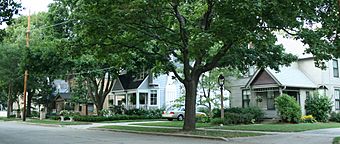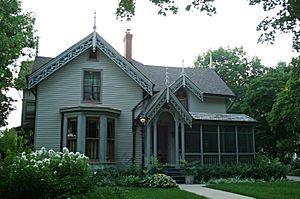Church Street Historic District (Wauwatosa, Wisconsin) facts for kids
Quick facts for kids |
|
|
Church Street Historic District
|
|

Church Street Historic District
|
|
| Location | Wauwatosa, Wisconsin |
|---|---|
| NRHP reference No. | 89001099 |
| Added to NRHP | August 10, 1989 |
The Church Street Historic District is a special neighborhood in Wauwatosa, Wisconsin. It's famous for its old homes, built between 1857 and 1920. These houses are so important that the area was added to the National Register of Historic Places in 1989. This means it's a place worth protecting because of its history.
Contents
- How Church Street Began
- Amazing Old Homes
- Thomas B. Hart House (around 1857)
- A.F. Kellogg House (1885)
- Daniel T. Pilgrim House (around 1885)
- First Congregational Parsonage (1885)
- Emma C. Caswell House (1887)
- L.T. Lehmann House (around 1891)
- John B. DeSwarte House (1891)
- Ferdinand Bark House (1893)
- August C.O. Peter House (around 1914)
- First Congregational Church (1919)
- Nathan Fronk House (around 1920)
- George B. Nase House (around 1920)
How Church Street Began
Wauwatosa started way back in 1835. It grew up around where Harwood Avenue and State Street are today. In 1853, part of what is now the Church Street area became the very first neighborhood with homes in Wauwatosa.
That same year, the Congregational church built its first building here. It was the first church in the community. This important church is why the street got its name: Church Street!
Amazing Old Homes
The Church Street Historic District has fourteen historic buildings that are still standing. They show how building styles changed over time in the United States. Here are some of the cool homes you can find there, listed in the order they were built:
Thomas B. Hart House (around 1857)
The Thomas B. Hart House at 1609 Church Street is a great example of Carpenter Gothic style. This style often has steep roofs and bay windows. Look closely at the fancy wooden decorations called bargeboards on the ends of the gables (the triangular parts of the roof). They were cut with a jigsaw into different patterns, like oak leaves and clover shapes. Thomas Hart was a very early settler. He helped start Wauwatosa by building a sawmill and a gristmill (a mill for grinding grain) nearby.
A.F. Kellogg House (1885)
The A.F. Kellogg house at 1460 Church Street is a two-story home built in the Queen Anne style. It was built in 1885. The wooden siding on the sides has cool horizontal and vertical boards. This detail comes from another style called Stick Style.
Daniel T. Pilgrim House (around 1885)
The Daniel T. Pilgrim house at 1514 Church Street is another two-story Queen Anne house from about 1885. It has a cross-gabled roof, which means the roof has gables pointing in different directions. The front of the house has angled corners. Its windows are decorated with fancy jig-sawn hood moulds (decorative frames). The roof edges are also decorated.
First Congregational Parsonage (1885)
The First Congregational Parsonage (a home for a church minister) at 1504 Church Street was built in 1885. This two-story Queen Anne building is right across from the Congregational Church. It features a cross-gabled roof, bay windows, and detailed porches.
Emma C. Caswell House (1887)
The Emma C. Caswell house at 1530-32 Church Street is a one-and-a-half-story house built in 1887. It has a porch with a hip roof (a roof that slopes on all four sides) across the front. The front gable is decorated with board and batten siding, which means strips of wood cover the seams between wider boards.
L.T. Lehmann House (around 1891)
The L.T. Lehmann house at 1630 Church Street is a two-and-a-half-story Queen Anne home built around 1891. It has a unique three-story corner tower with a bell-shaped roof. The house is decorated with shingles on the gables and between the first and second floors. You can also see delicate spindle-work on the porch.
John B. DeSwarte House (1891)
The John B. DeSwarte house at 1622 Church Street is a one-and-a-half-story house built in 1891. It mixes different styles. The bay windows, exposed chimney, and shingled gables are clearly Queen Anne. But the roof shapes, the small shed-roofed dormer (a window that sticks out from a sloping roof), and the gambrel roof (a roof with two different slopes on each side) might come from the Shingle style.
Ferdinand Bark House (1893)
The Ferdinand Bark house at 1612 Church Street is a two-story Queen Anne home built in 1893. It has a cross-gabled roof and cutaway corners on the first floor. The gables are decorated with "fish-scale" shingles, which look like fish scales.
August C.O. Peter House (around 1914)
The August C.O. Peter house at 1621 Church Street is a two-and-a-half-story Colonial Revival house built around 1914. This style usually has a front that looks balanced and even. The main entrance has a porch roof held up by two Tuscan columns. On one side, there's a screened porch with a balustrade (a row of small columns) on its roof.
First Congregational Church (1919)
The current First Congregational Church building is a Georgian Revival style building. It was designed by Edwin O. Kuenzli, who was a member of the church, and built in 1919. Kuenzli was inspired by an old church in Williamstown, Massachusetts. Like most Georgian Revival buildings, its walls are made of red brick with white trim. The front entrance has a pedimented portico (a porch with a roof supported by columns) with four tall Doric columns. Above that, a large white belfry (bell tower) rises three stories high. This is the same church group that built the first church here in 1853, giving Church Street its name.
Nathan Fronk House (around 1920)
The Nathan Fronk house at 1448 Church Street is a one-and-a-half-story home built around 1920. It's made of cream-colored brick in the Spanish Colonial Revival style. You can tell by the rounded parapets (low walls) on the ends of the gables. There's also a garage behind the house that matches this style.
George B. Nase House (around 1920)
The George B. Nase house, at 7758 W. Menomonee River Parkway, is a one-story Prairie Style home. It was designed by Russell Barr Williamson and built around 1920. This style is known for its horizontal lines, hip roof (a roof that slopes on all four sides), wide eaves (the parts of the roof that hang over the walls), and stucco exterior. It also has "ribbons" of casement windows (windows that open outward like a door). There's a matching garage behind the house too.




